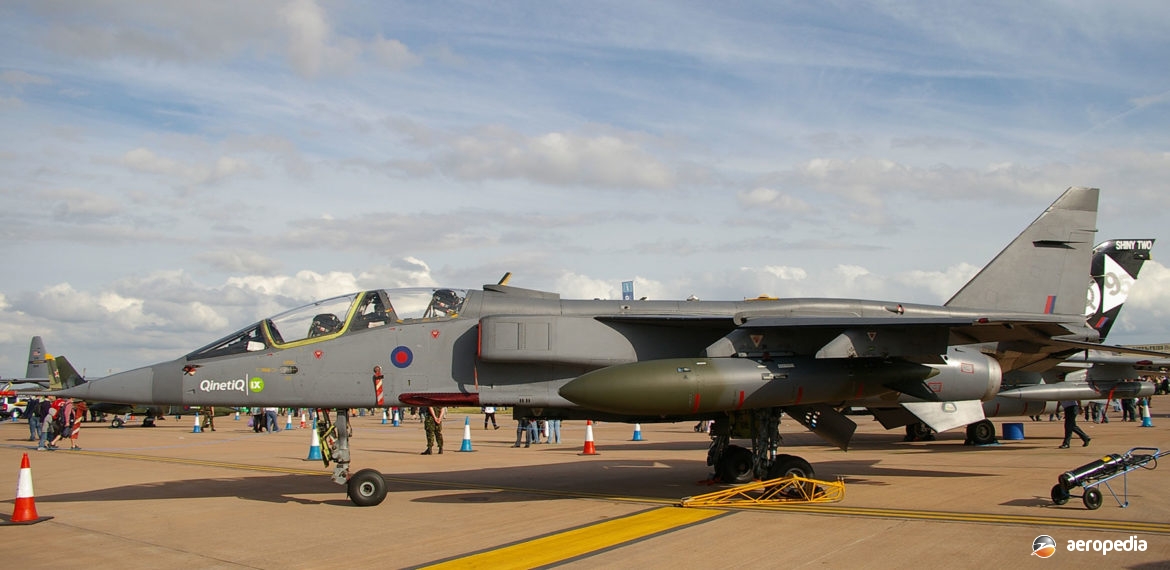Photograph:
Sepecat Jaguar at RAF Fairford in the United Kingdom in July 2007 (John Tulloch)
Country of origin:
United Kingdom / France
Description:
Single-seat ground-attack aircraft
Power Plant:
Two 7,305 lbst Rolls Royce / Turbomeca Adour Mk 102 turbofans
Specifications:
- Wingspan: 8.69 m (28 ft 6 in)
- Length: 16.83 m (55 ft 3 in)
- Height: 4.92 m (16 ft 1 in)
- Wing area: 24 m² (258 sq ft)
- Max speed: 1,593 km/h (1,055 mph) – Mach 1
- Range: 535 km (335 miles)
- Ferry range: 3,525 km (2,190 miles)
- Service ceiling: 14,000 m (46,000 ft)
- Empty weight: 7,000 kg (15,400 lb)
- Loaded weight: 11,000 kg (24,250 lb)
- Max take-off weight: 15,700 kg (34,600 lb)
Armament:
Two 30 mm Aden or Defa cannon; five external hardpoints with a capacity of 4,540 kg (10,000 lb) and able to carry two AIM-9 Sidewinders, Matra R-550 Magic, eight Matra rocket pods, AS-37 Martel missiles and a range of bombs, reconnaissance pods and drop tanks
History:
The Jaguar was the culmination of an agreement between the United Kingdom and France to develop a ground attack aircraft which could also be sold to foreign services. The program commenced in the 1960s as a replacement for the Folland Gnat T-1 and Hawker Hunter T-7 for the RAF, and as a cheap, subsonic, dual-role trainer and light attack aircraft for the French Air Force. After development, requirements changed and a new requirement was issued for a close air-support, tactical reconnaissance, and tactical aircraft to replace the McDonnell F-4K Phantom in RAF service and the Dassault Etenard in French service.
Sepecat was formed in 1966 as a joint venture between Breguet, later Dassault Aviation, and British Aircraft Corp to produce the airframe and a separate team from Rolls Royce and Turbomeca developed the Adour afterburning turbofan engine. The first of eight prototypes flew on 8 September 1968, the Jaguar being a single-seat, swept-wing, twin-engine aircraft with a combat radius on internal fuel of 850 km (530 miles) and a max speed of Mach 1.6 at altitude and Mach 1.1 at sea level. First production aircraft were delivered to the French Air Force in 1973, receiving eventually 160 single-seaters, also receiving 40 of the two-seat Jaguar E variant for conversion training.
During its operational life the aircraft received a number of up-dates and was eventually replaced by the Eurofighter Typhoon in RAF service and the Dassault Rafale in French service. UK Treasury defence cuts meant an early retirement in 2007 but it continued in service in up-graded form in India, where 120 aircraft were fitted with more powerful engines and up-dated electronics to improve performance. A total of 165 single-seat Jaguar GR.1s was supplied to the RAF from 1974, with a further 35 T.2s being supplied for training. Examples were also supplied to Ecuador, Nigeria and Oman.
Following retirement a number were placed in museums. The forward fuselage of one was obtained by Mr Paul Cunningham in Victoria to join his Sukhoi Su-22 fuselage for display purposes, being placed on a trailer and towed to various aviation events.

